FORMULASI DAN UJI ANTIBAKTERI EKSTRAK BIJI KETUMBAR (Coriandrum sativum L.) PADA SEDIAAN SPRAY GEL ANTIJERAWAT DENGAN VARIASI CARBOPOL 940
DOI:
https://doi.org/10.59003/nhj.v5i2.1559Keywords:
coriander seeds, antibacterial, spray gelAbstract
Acne is a skin problem or infection that generally appears on the face, neck, chest, and back. Acne is caused by the bacteria Propionibacterium acnes. Acne treatments that are often used are topical medications containing synthetic antibiotics. However, the use of these drugs can cause adverse resistance. Another alternative for acne therapy is using natural ingredients. This study aims to determine the antibacterial activity of coriander seed extract in a spray gel preparation. Flavonoid, terpenoid, saponin and tannin compounds contained in seeds This study is an experimental laboratory study using the disc diffusion method with 5 treatments, namely coriander seed extract with a concentration of carbopol F1 0.1%, F2 0.2%, F3 0.3%, a positive control spray gel brand "X" and a negative control only base without extract. The process of making coriander seed extract is carried out through the maceration method for 3x24 hours with 70% ethanol solvent. The filtrate obtained is then evaporated using a water bath to become a thick extract and continued for making spray gel preparations and antibacterial testing. The results of the research on the spray gel formulation from coriander seed extract showed the organoleptic physical characteristics of F1, F2, F3 were yellowish brown, liquid, and had a distinctive coriander odor. The pH test was 6.46; 6.32; 6.04, the viscosity test was 93.43 cP; 81.10 cP; 78.67 cP, the adhesiveness test of all formulas was stated not to drip for 10 seconds, and the spreadability was 6.01 cm; 5.48 cm; 4.42 cm. In the antibacterial test of the spray gel preparation, the inhibition zone value was obtained, namely F1 5.97 mm, F2 6.05 mm, F3 6.08 mm, and the positive control 10.10 mm. Based on the research of the three formulations, the most optimal spray gel preparation was F2 because it met the requirements of the physical test and antibacterial test.
Downloads
References
Agustin, V., Ismiyati, N., & Sulistyawati, R. (2023). Formulasi Sediaan Gel Totol Jerawat Ekstrak Bunga Melati (Jasminum sambac L). Indonesian Journal on Medical Science, 10 (1), 31–36. Https://Doi.Org/10.55181/Ijms.V10i1.413
Ardhana, C. P., Yamlean, P. V. Y., & Abdullah, S. S. (2024). Uji Stabilitas Fisik Sediaan Pelembab Bibir (Lip Balm) Ekstrak Etanol Buah Tomat (Solanum lycopersicum L.). Pharmacon, 13 (1), 441. Https://Doi.Org/10.35799/Pha.13.2024.49321
Estikomah, S. A., Amal, A. S. S., & Safaatsih, S. F. (2021). Uji Daya Hambat Terhadap Bakteri Staphylococcus aureus, Staphylococcus epidermidis, Propionibacterium acnes Gel Semprot Ekstrak Etanol Daun Kersen (Muntingia calabura L.) Karbopol 940. Pharmaceutical Journal of Islamic Pharmacy, 5 (1), 37–50.
Fadel, M. N., Setyowati, E., Besan, E. J., & Rahmawati, I. (2023). Efektivitas Antidiabetes Ekstrak Etanol Bunga Telang (Clitoria Ternatea L.) Metode Induksi Aloksan. Indonesia Jurnal Farmasi, 8 (2), 63–64. Https://Doi.Org/10.26751/Ijf.V8i2.2251
Fadillah, N. (2024). Uji Efektivitas Antibakteri Sediaan Gel Spray Ekstrak Etanol Daun Sawo Manila (Manilkara Zapota L.) Terhadap Propionibacterium Acnes. Medicine And Health Science, 15 (1). Universitas Muhammadiyah Makassar.
Firmansyah, F., Khairiati, R., Muhtadi, W. K., & Chabib, L. (2022). Uji Aktivitas Antibakteri Serum Ekstrak Etanol Buah Belimbing Wuluh Terhadap Propionibacterium Acnes, Staphylococcus Aureus, Dan Staphylococcus Epidermis. Original Article Mff, 26 (2), 69–73. doi.Org/10.20956/Mff.V26i2.18578
Hamdaniyah, I., Ambarwati, N., & Hardani, P. T. (2024). Formulasi Dan Uji Karakterisasi Lip Cream Dari Ekstrak Kulit Buah Naga (Hylocereus polyrhizuz) Dengan Perbandingan Stiffening Agent. Jurnal Kesehatan Tambusai, 5, 7640–7642.
Harefa, K., Aritonang, B., & Ritonga, A. H. (2022). Aktivitas Antibakteri Ekstrak Etanol Kulit Markisa Ungu (Passiflora Edulis Sims) Terhadap Bakteri Propionibacterium Acnes. Jurnal Multidisiplin Madani, 2 (6), 2747–2748. doi.Org/10.55927/Mudima.V2i6.469
Hasanah, N., & Dori, R. S. (2019). Daya Hambat Ekstrak Biji Ketumbar (Coriandrum sativum L.) Terhadap Pertumbuhan Bakteri Shigella dysenteriae Metode Cakram. Edu Masda Journal, 3 (2), 115. https://Doi.Org/10.52118/Edumasda.V3i2.33
Hijriah, N. M., Filianty, F., & Nurhasanah, S. (2022). Potensi Minyak Atsiri Daun Ketumbar (Coriandrum sativum L.) Sebagai Pendukung Pangan Fungsional: Kajian Literatur. Jurnal Teknotan, 16 (1), 43–45. https://Doi.Org/10.24198/Jt.Vol16n1.8
Karlina, D. W., Noval, & Yuwindry, I. (2024). Formulasi Dan Evaluasi Nano Spray Gel Dengan Ekstrak Daun Sirih Merah (Piper crocatum Ruiz & Pav ) sebagai Antioksidan Dengan Variasi Konsentrasi Carbopol 940. Jurnal Surya Medika, 10 (2), 289–292. https://Doi.Org/Https://Doi.Org/10.33084/Jsm.V10i2.7754
Khabibah, L. D. (2021). Optimasi Fraksi Biji Ketumbar (Coriandrum Sativum L.) Terhadap Bakteri Staphylococcus aureus Atcc 25923 Secara In Vitro. Pharmacognosy Magazine, 75 (17). Sekolah Tinggi Ilmu Kesehatan Karya Putra Bangsa Tulungagung.
Khan, I. U., Dubey, W., & Gupta, V. (2014). Taxonomical Aspect Of Coriander (Coriandrum Sativum L.). International Journal of Current Research, 6 (11), 9926–9930.
Khudzaifi, M., Fadel, M. N., Arif, F., Akhyasin, A., & Retnowati, E. (2022). Uji Aktivitas Antijamur Sediaan Krim Ekstrak Etanol Daun Ciplukan (Physalis Angulata L.) Terhadap Candida albicans. Indonesia Jurnal Farmasi, 7 (1), 40. Https://Doi.Org/10.26751/Ijf.V7i2.1762
Khudzaifi, M., Manik, N., Fadel, M. N., Kurniawan, G., & Presticasari, H. (2023). Perbandingan Kadar Flavonoid Sebagai Antibakteri Dari Ekstrak Batang Pisang Kepok (Musa Balbisiana ) Dan Ekstrak Batang Pisang Ambon (Musa Acuminata) Terhadap Bakteri Staphylococcus Aureus. Indonesia Jurnal Farmasi, 8 (2), 114–116. doi.Org/10.26751/Ijf.V8i2.2261
Kresnawati, Y., Fitrianingsih, S., & Purwaningsih, C. P. (2022). Formulasi Dan Uji Potensi Sediaan Spray Gel Niasiamida Dengan Propilenglikol Sebagai Humektan. Cendekia Journal of Pharmacy, 6 (2), 284–288. https://Doi.Org/10.31596/Cjp.V6i2.214
Lestari, R. T., Gifanda, L. Z., Kurniasari, E. L., Harwiningrum, R. P., Kelana, A. P. I., Fauziyah, K., Widyasari, S. L., Tiffany, Krisimonika, D. I., Salean, D. D. C., & Priyandani, Y. (2021). Perilaku Mahasiswa Terkait Cara Mengatasi Jerawat. Jurnal Farmasi Komunitas, 8 (1), 15–17.
Madelina, W., & Sulistiyaningsih. (2018). Review: Resistensi Antibiotik Pada Terapi Pengobatan Jerawat. Jurnal Farmaka, 16 (2), 105–107.
Marlina, D., Fadly, & Fathya, Z. (2021). Formulasi Dan Evaluasi Spraygel Anti Jerawat Ekstrakkayu Secang (Caesalpinia Sappan L.) Dengan Variasi Konsentrasi Carbopol 940 Sebagai Gelling Agent Formulationand. Jurnal Kesehatan Pharmasi, 3 (2), 132–138.
Munaeni, W., Carlen Mainassy, M., Puspitasari, D., Susanti, L., Cholis Endriyatno, N., Yuniastuti, A., Ketut Wiradnyani, N., Nanda Fauziah, P., Adriani, Febriza Achmad, A., Kurnia Rohmah, M., Fadhilah Rahman, I., Yulianti, R., Yulinda Cesa, F., Adriani Hendra, G., & Rollando. (2022). Manfaat Obat Herbal (Mika Tri K). Toha Media. https://Toharmedia.Co.Id
Mundriyastutik, Y., Muslimah, A. C., Hasriyani, & Lestari, D. T. (2023). Penyembuhan Luka Bakar Dengan Sediaan Topikal Spray Gel Ekstrak Daun Peletakan (Ruellia Tuberosa L) Pada Tikus Putih (Wistar). Indonesia Jurnal Farmasi, 8 (2), 86–87. https://Doi.Org/10.26751/Ijf.V8i2.2230
Mutiasari, A. S. (2018). Uji Aktivitas Antibakteri Minyak Atsiri Biji Ketumbar (Coriandrum Sativum L.) Dan Nanoemulsinya Terhadap Staphylococcus Epidermis. Skripsi. Universitas Jember.
Nasution, S. (2017). Variabel Penelitian. Raudhah, 05 (02), 1–9.
Puspita, W., Puspasari, H., & Shabrina, A. (2021). Formulasi Dan Stabilitas Fisik Gel Semprot Ekstrak Daun Buas-Buas (Premna Serratifolia L.). Pharmacon: Jurnal Farmasi Indonesia, 1–8. Https://Doi.Org/Http://Journals.Ums.Ac.Id/Index.Php/Pharmacon
Rahmah, M. H., Markia, Rahman, S. R., Ramlah, & Isdaryanti. (2024). Identifikasi Kandungan Fenolik Pada Ekstrak Maserasi Bertingkat Dari Daun Segar Dan Daun. Jurnal Ilmu Biologi, 6 (1), 96–97.
Rahmawati, R. P., Anggun, L., Primandana, A. Z., & Dwiyanti, U. (2021). Pengaruh Pemberian Ekstrak Etanol 96% Daun Suruhan (Peperonia pellucida (L.) Kunth) Terhadap Pertumbuhan Bakteri Propionibacterium acnes Dengan Metode Difusi Cakram. Indonesia Jurnal Farmasi, (1), 23–26. Https://Doi.Org/10.26751/Ijf.V6i1.1196
Rifqi, M. (2021). Ekstraksi Antosianin Pada Bunga Telang (Clitoria ternatea L.). Pasundan Food Technology Journal, 8 (2), 46–49.
Rizki, S. A., Latief, M., & Rahman, H. (2021). Uji Aktivitas Antibakteri Ekstrak N-Heksan, Etil Asetat Dan Etanol Daun Durian (Durio zibethinus Linn.) Terhadap Bakteri Propionibacterium acnes dan Staphylococcus epidermidis. Jurnal Mahasiswa Farmasi, 451–453.
Rowe, R. C., & Quinn, P. J. S. And M. (2023). Pharmaceutical Excipients. In R. C. Rowe & P. J. S. And M. Quinn (Eds.), Royal Pharmaceutical Society Of Great Britain (Sixth Edit, Vol. 1). Pharmaceutical Press. Https://Doi.Org/10.1016/B978-0-323-91817-6.00003-6
Setiyono, N. B. (2021). Skrining Fitokimia Dan Penetapan Kadar Flavonoid Total Ekstrak Etanol Dan Ekstrak Air Daun Serta Biji Ketumbar (Coriandrum Sativum L.). In Pharmacognosy Magazine, 75 (17). Sekolah Tinggi Ilmu Kesehatan Nasional Surakarta.
Sitanggang, Z. Z. & A. K. T. (2021). Daya Hambat Ekstrak Etanol Biji Ketumbar (Coriandrum sativum L .) Terhadap Pertumbuhan Bakteri Staphylococcus aureus Dan Pseudomonas aeruginosa. Skripsi. Universitas Prima Indonesia Medan.
Stephan, W., Armita, A., Fadillah, Q., & Ferdinand, S. (2022). Uji Efektivitas Antibakteri Ekstrak Kayu Bajakah (Spatholobus littoralis Hassk) Terhadap Bakteri Pseudomonas Aeruginosa. Jambura Journal of Health Sciences and Research, 4 (3), 672–675. https://Doi.Org/10.35971/Jjhsr.V4i3.12368
Suci, S. (2022). Uji Efektifitas Sediaan Gel Minyak Atsiri Kulit Jeruk Pamelo (Citrus maxima Merr.) Terhadap Bakteri Staphylococcus Aureus Dan Propionibacterium Acnes, 9. Stikes Bhakti Husada Mulia Madiun.
Ummah, M. S. (2019). Perbedaan Zona Hambat Pertumbuhan Propionibacterium Acnes Pada Berbagai Konsentrasi Cuka Apel (Apple Cider Vinegar) Secara In Vitro. Sustainability (Switzerland), 11 (1), 1–14.
Wahyuningsih, E. S., Roswati, R., Gunarti, N. S., & Fikayuniar, L. (2023). Formulasi Dan Uji Aktivitas Antibakteri Krim Ekstrak Etanol Biji Ketumbar (Coriandrum sativum L,.) Terhadap Propionibacterium Acnes. Prosiding Seminar Nasional Diseminasi Penelitian, 3 (1), 1–10.
Zai, Z., & Sitanggang, A. K. T. (2021). Daya Hambat Ekstrak Etanol Biji Ketumbar (Coriandrum Sativum L.) Terhadap Pertumbuhan Bakteri Staphylococcus Aureus Dan Pseudomonasaeruginosa. Universitas Prima Indonesia.
Downloads
Published
How to Cite
Issue
Section
License
Copyright (c) 2025 Muhammad Zielal Askari

This work is licensed under a Creative Commons Attribution-NonCommercial-ShareAlike 4.0 International License.
NHJ is licensed under a Creative Commons Attribution-NonCommercial-ShareAlike 4.0 International License.
Articles in this journal are Open Access articles published under the Creative Commons CC BY-NC-SA License This license permits use, distribution and reproduction in any medium for non-commercial purposes only, provided the original work and source is properly cited.
Any derivative of the original must be distributed under the same license as the original.
























